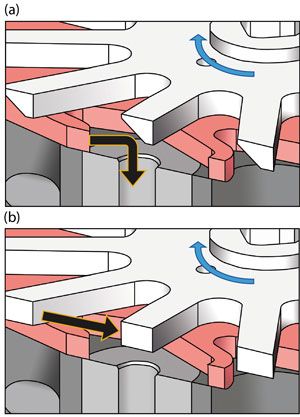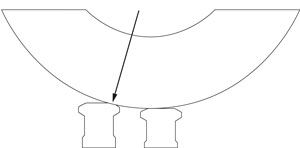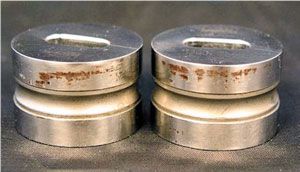Press Adjustments Help Prevent Tableting Problems
Equipment and Processing Report
Adjusting the tablet press and its systems can prevent manufacturing and product quality problems.
Tablet compression is a science and an art, and a host of factors contribute to a successful product run. Some of the most troublesome problems that manufacturers encounter, including insufficient tablet hardness, inconsistent tablet weight, incorrect flow of formulation through the feed system, and tool damage, can often be corrected by making adjustments to the tablet press or its systems. This article will discuss potential problems and how to adjust for them.
Specifying fill cams
Although many common tableting problems may be solved by making adjustments to the press, it is just as important to select the proper machine components, such as fill cams and feeder paddles. Choosing the correct fill cam is crucial to clean press operation and consistent tablet weight. Rotary tablet presses operate on the overfill principle, in which more powder is filled into the die bores than required, and the lower punch is then raised to eject the excess by the weight/dosing cam. This procedure is essential to obtaining consistent tablet weight. If the fill cam is too shallow, weight variation may occur due to insufficient die-bore overfill. If the fill cam is too deep, excess material will be ejected onto the die table or reintroduced into the feeder, depending on the type of press. If material is ejected back onto the die table, it will collect around the neck of the turret and then be forced outwards due to centrifugal force. The dies may then be refilled after passing over the weight/dosing cam, resulting in weight variation. In presses where the excess material is reintroduced to the feeder, it may undergo shear forces in the paddle feeder, resulting in particle-size reduction or densification, which affects tablet quality.
Correcting feeding and flow problems
A frequent problem with feeding material into the tablet press is bridging of material in the hopper, which results in feeder starvation (i.e., no material in the feeder) and/or overfill of the feeder, because the weight of the powder can cause compaction. A lack of freely flowing powder can result in variation in tablet weight. Material bridging can be identified by visual inspection through the sight window in the hopper or feeder. If the press is not equipped with these, problems can be observed by monitoring the progress of powder flow in the hopper from above. Most commonly, bridging and other flow problems are due to formulation issues such as cohesive formulation components, excessive moisture, or irregular particle shapes.

Feeder paddle configuration also plays an important role in tablet consistency, because it affects die bore fill and tablet weight, which correlate directly to proper API dosage and are therefore crucial. One simple, yet effective, feeder paddle option is implementing paddles with a 45-degree angle on the leading edge of the paddle blades (see Figure 1). This configuration is particularly helpful with light or “fluffy” formulations where consistent die bore fill is problematic. The angled blades direct powder down rather than just pass it over the die bores. This configuration has also improved die fill with good flowing formulations, resulting in standard tablet weight deviation being reduced by as much as 75%.
Most modern presses are equipped with human-machine-interface-controlled operating systems. Tablet weight control is automatically adjusted by statistical process control based on compression force. Theoretically, this would eliminate the need for the operator to make manual adjustments, but these systems are not 100% reliable due to worn parts, improper calibration, or software issues. An “old school” experienced operater can sense weight variation by listening to, or touching, a press while it is in operation and, based on the harmonics of the press sound and vibration, can make manual adjustments to maintain proper tablet weight.
One way to correct flow issues is to adjust the formulation. If the formulation cannot be changed, then the hopper will need to be modified, possibly by fabricating a new hopper with an optimal wall angle to allow proper flow. Results of powder rheology testing can predict the hopper angle needed for acceptable flow or indicate the need to add a glidant to assist with powder flow.
Another method that can be used to encourage flow is to insert a vibratory rod into the hopper transition to agitate the formulation. Mounting a vibrator directly on the hopper may exacerbate the problem by causing product separation.
Adjusting press parameters
Several adjustments can be made to the tablet press to improve tablet hardness and ensure proper die-bore fill and tablet weight. Proper rotation speed (i.e., RPM) of the feeder and turret as well as proper setting of upper punch penetration and precompression are all crucial to achieving tablet hardness.
Rotation speed. Correct feeder RPM can affect tablet hardness by ensuring proper filling of die bores. In addition, high RPM may induce particle attrition, thus leading to compaction issues. The mating surfaces of the die table and feed frame(s) must be properly aligned and adjusted for a press to run cleanly. Lack of press cleanliness is one of the most common causes of press and tooling failure. It is important to perform a visual inspection for wear or damage when setting up the tablet press. These surfaces must be in good condition or formulation leaks may occur, again affecting tablet weight.
Proper turret RPM can significantly affect tablet hardness. Sometimes it may be necessary to slow the press down to increase dwell time to achieve proper tablet hardness.

Upper punch penetration. It is generally better to run minimal upper-punch penetration (to help prevent air entrapment) and to reduce tablet ejection travel in the die bore. This practice also reduces lower punch movement, which generates heat. Heat is the enemy, because it increases sticking and picking issues. Increasing upper punch penetration, however, may aid in achieving tablet hardness. Because the punch heads will make contact with the upper roller at an earlier point, compression time will be increased. This parameter is not to be confused with dwell time, which is when the punch head flats are passing between the rollers. Figure 2 shows how the compression time is affected by the upper punch penetration.
Correct tool configuration can also affect dwell time. A "D" punch has a larger head flat than a "B" punch, and the larger head flat generally results in a harder tablet due to increased dwell time. When necessary, specialty or custom tooling with larger head flats can be manufactured to increase dwell time.
Precompression. Precompression is probably one of the most improperly used adjustments on a tablet press. Precompression is often set using a percentage of final compression, but in the author's opinion, this method is not a good practice because the operator does not truly know what is happening to the formulation prior to final compression. If insufficient precompression is used, there may be increased air entrapment, resulting in capping and/or laminating. If too much precompression is used, a tablet can become fractured. Often mistaken for soft tablets, fractured tablets are analogous to a safety glass window that has been hit with a rock; it may remain in its original form, but it won’t have any strength due to all of the cracks that have formed. A tablet hardness tester will not be able to distinguish between soft and fractured tablets. By setting pre-compression manually an operator can observe the effect of compression force applied. With all main compression force backed off and turning the turret manually, tablets should be formed at the ejection point but should be weak enough to break apart when handled or ejected down the tablet chute. Minor increased or decreased pressure adjustments may be required after start up, but this is an effective beginning point.
Maintenance and training
Regular inspection and maintenance of the tablet press and its parts is mandatory for successful tableting operations. In addition to proper cleaning and lubrication, the press should be visually inspected as often as possible. Metal parts should be checked for fretting wear (see Figure 3). Fretting on machine parts is often misinterpreted as rust, but it is actually microwelding of two mating parts that results from cyclic motion, due to increased clearances created by wear. Fretting is most commonly observed on dies that have cracked, which indicates worn die pockets. It appears at the top of the die as depicted in Figure 3. The top of the die pocket suffers the most damage due to improper die installation. Fretting can also be observed on punches, but does not appear as clearly as it does on the dies or other press parts. Because punches are in motion in their guides, residual microwelded material is worn off.

The turret is the heart of the tablet press; for successful tableting it is crucial that the turret remains within specification. Use inspection gauges to confirm turret wear. These gauges check the alignment between upper and lower sections, punch guide/die-pocket wear, and punch-tip to die-bore concentricity. If these areas become worn, tooling may be damaged resulting in poor table quality. Worn turrets need to be refurbished or replaced.
Tablet presses are designed to allow for many automated and manual adjustments. If press operators are not trained properly, however, these adjustments can be useless. Operators must understand why the adjustments are being made, and what impact they will have on the tablets. Nothing can replace well-trained, experienced operators in ensuring product quality and meeting production schedules.
About the Author
Doug Kirsch is technical service manager of the Tablet Press Division for Natoli Engineering Company.
Article DetailsPharmaceutical Technology
Vol. 39, Issue 5
Pages: 58-59
Please cite this article as: D. Kirsch, "Fixing Tableting Problems," Pharmaceutical Technology 39 (5) 2015.
Drug Solutions Podcast: A Closer Look at mRNA in Oncology and Vaccines
April 30th 2024In this episode fo the Drug Solutions Podcast, etherna’s vice-president of Technology and Innovation, Stefaan De Koker, discusses the merits and challenges of using mRNA as the foundation for therapeutics in oncology as well as for vaccines.
Drug Solutions Podcast: Gliding Through the Ins and Outs of the Pharma Supply Chain
November 14th 2023In this episode of the Drug Solutions podcast, Jill Murphy, former editor, speaks with Bourji Mourad, partnership director at ThermoSafe, about the supply chain in the pharmaceutical industry, specifically related to packaging, pharma air freight, and the pressure on suppliers with post-COVID-19 changes on delivery.
Pharmaceutical Tariffs Are Imminent: How Industry is Bracing for Impact
April 16th 2025On April 14, 2025, the Trump Administration launched a national security-driven investigation into pharmaceuticals, a move that will likely result in tariffs being placed on pharmaceutical drugs, ingredients, and other components that are imported from outside of the United States.
